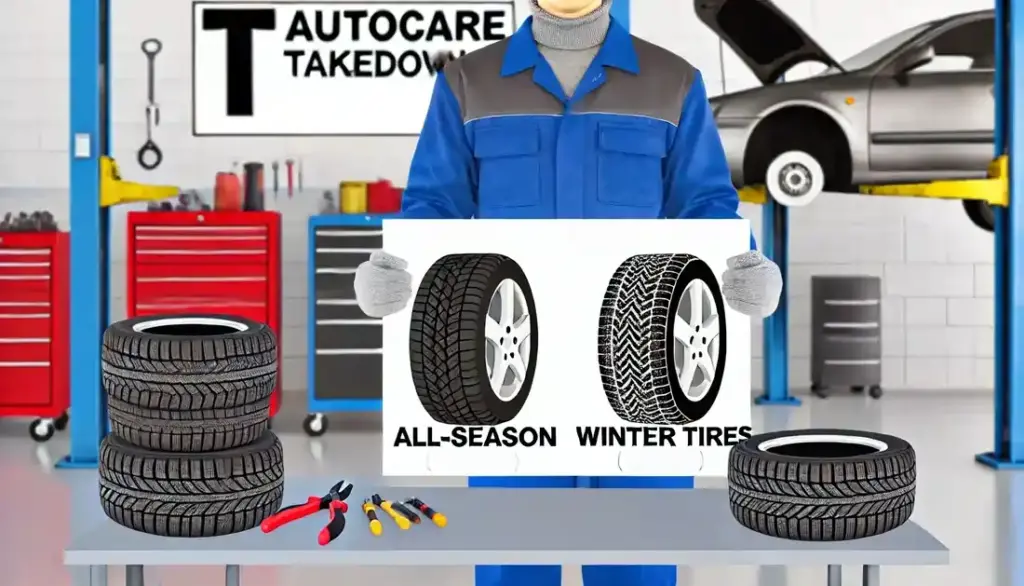Choosing the right tires for your vehicle is crucial for safety, performance, and convenience. At T Autocare Takedown, we want to help you make an informed decision between all-season and winter tires. Here’s a comprehensive guide that goes beyond the basics to ensure you have all the information you need.

Introduction
Understanding the differences between all-season and winter tires can help you make the best choice for your driving conditions. Both types of tires have specific benefits and drawbacks, which we will explore in this guide.
How All-Season and Winter Tires Work
- All-Season Tires: Designed for versatility, these tires perform well in a variety of conditions, including dry, wet, and light snowy roads. They have a balanced tread design and a rubber compound that remains flexible in a wide range of temperatures, making them suitable for year-round use.
- Winter Tires: Engineered specifically for cold weather, winter tires feature deeper tread patterns and a rubber compound that stays pliable in low temperatures. This design provides superior traction on snow and ice, ensuring safety and control during winter months.
Factors to Consider When Choosing Tires
- Climate and Temperature
- All-Season Tires: Best for regions with mild to moderate winters. They perform well in temperatures above 45°F (7°C) but may struggle in severe winter conditions.
- Winter Tires: Essential for areas with harsh winters, frequent snow, and icy roads. They excel in temperatures below 45°F, offering better grip and safety.
- Driving Conditions
- All-Season Tires: Ideal for drivers who face a mix of weather conditions without extreme winter weather. They offer convenience and eliminate the need for seasonal tire changes.
- Winter Tires: Recommended for those who frequently drive on snow-covered or icy roads. They provide the necessary traction and safety in winter conditions.
- Performance and Longevity
- All-Season Tires: Generally have a longer lifespan, lasting between 50,000 to 75,000 miles depending on driving habits and maintenance. They offer a balance of performance across different conditions.
- Winter Tires: Typically last about 3 to 4 winter seasons or roughly 15,000 to 20,000 miles. Their performance is optimized for winter but can wear out quickly if used in warmer temperatures.
- Cost and Maintenance
- All-Season Tires: Lower initial cost and less maintenance since they do not require seasonal changes. However, they may not provide optimal safety in extreme winter conditions.
- Winter Tires: Higher initial cost due to the need for a separate set of tires. Seasonal changes and storage can add to the expense, but they offer enhanced safety during winter months.
Unique Tips for Choosing and Using Tires
Consider All-Weather Tires: If you live in a region with mild winters but still experience occasional snow, all-weather tires can be a great compromise. They combine elements of both all-season and winter tires.
Use Tire Covers for Storage: Protect your off-season tires with tire covers to prevent damage from exposure to elements.
Regular Tire Maintenance: Regardless of your choice, regular tire maintenance such as proper inflation, rotation, and alignment can extend the lifespan of your tires and ensure optimal performance.
Conclusion
Choosing between all-season and winter tires depends on your specific driving conditions, climate, and personal preferences. While all-season tires offer convenience and versatility, winter tires provide unmatched safety and performance in harsh winter conditions.
For personalized advice and expert tire services, trust our experienced auto repair team in Broken Arrow to help you make the best decision for your driving conditions.
By understanding the differences and benefits of each tire type, you can ensure your vehicle is well-equipped for any season. Trust the experts at T Autocare Takedown for all your vehicle maintenance and repair needs.
Contact Us:
- Address: 1501 W Detroit St, Broken Arrow, OK 74012
- Phone: (539) 367-3738












